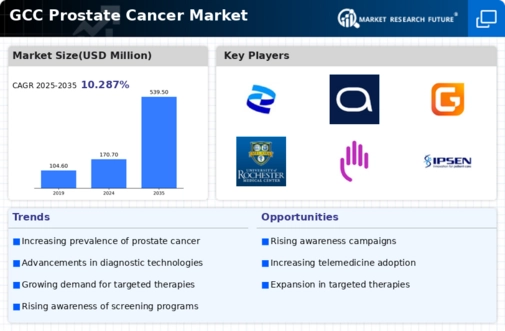Increasing Incidence Rates
experiencing growth due to rising incidence rates in the GCC region.. Recent data indicates that prostate cancer is one of the most commonly diagnosed cancers among men in this area. The increasing prevalence of risk factors, such as age and lifestyle changes, contributes to this trend. As the population ages, the number of men at risk for prostate cancer is expected to rise, leading to a greater demand for screening and treatment options. This surge in cases is likely to drive investments in healthcare infrastructure and research, ultimately benefiting the prostate cancer market. Furthermore, the GCC countries are focusing on improving cancer care, which may enhance early detection and treatment outcomes, thereby expanding the market further.
Rising Healthcare Expenditure
The prostate cancer market is likely to benefit from the rising healthcare expenditure in the GCC region. As countries invest more in healthcare infrastructure, there is a corresponding increase in the availability of advanced treatment options and technologies. This trend is evident in the growing number of specialized cancer treatment centers and the introduction of innovative therapies. Increased healthcare spending also facilitates better access to medications and support services for patients. Consequently, as healthcare budgets expand, the prostate cancer market is expected to experience growth, driven by improved treatment accessibility and enhanced patient care.
Government Initiatives and Funding
Government initiatives aimed at cancer control are playing a pivotal role in shaping the prostate cancer market. In the GCC, various health ministries are launching campaigns to promote awareness and early detection of prostate cancer. These initiatives often include funding for research, public health campaigns, and the establishment of specialized cancer centers. For instance, increased budget allocations for cancer care can lead to improved access to screening and treatment facilities. As governments prioritize cancer care, the prostate cancer market is expected to benefit from enhanced resources and support, which may lead to better patient outcomes and increased market growth.
Technological Innovations in Diagnostics
Technological advancements in diagnostic tools are significantly impacting the prostate cancer market. Innovations such as MRI-guided biopsies and liquid biopsies are enhancing the accuracy of prostate cancer detection. These technologies allow for earlier diagnosis and more personalized treatment plans, which are crucial in managing the disease effectively. The integration of artificial intelligence in imaging and pathology is also streamlining the diagnostic process, potentially reducing the time from diagnosis to treatment initiation. As healthcare providers in the GCC adopt these advanced technologies, the market is likely to see an increase in the number of diagnosed cases, leading to higher demand for treatment options and services.
Growing Patient Advocacy and Support Groups
The emergence of patient advocacy and support groups is influencing the prostate cancer market positively. These organizations play a crucial role in raising awareness about prostate cancer and providing resources for patients and their families. They often collaborate with healthcare providers to promote early detection and treatment options. In the GCC, the establishment of such groups is fostering a supportive environment for patients, which may lead to increased screening rates and treatment adherence. As more individuals become informed about prostate cancer, the demand for services and therapies in the market is likely to rise, contributing to overall market growth.

















Leave a Comment